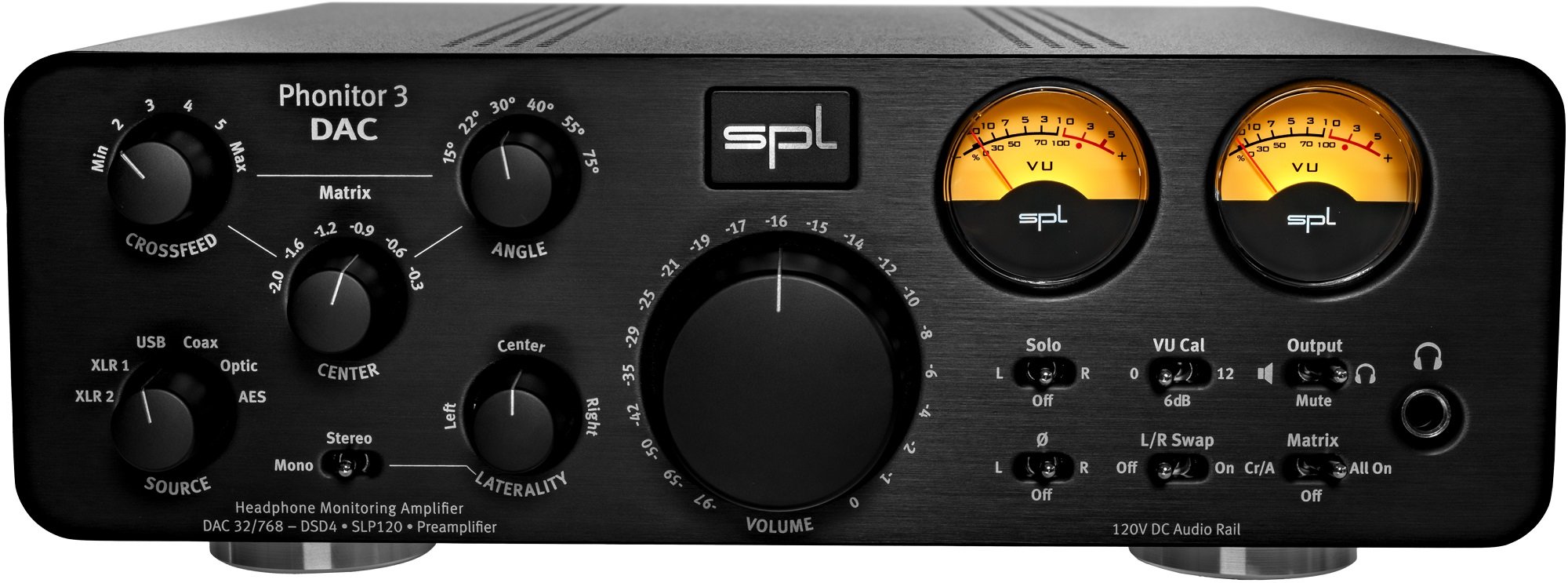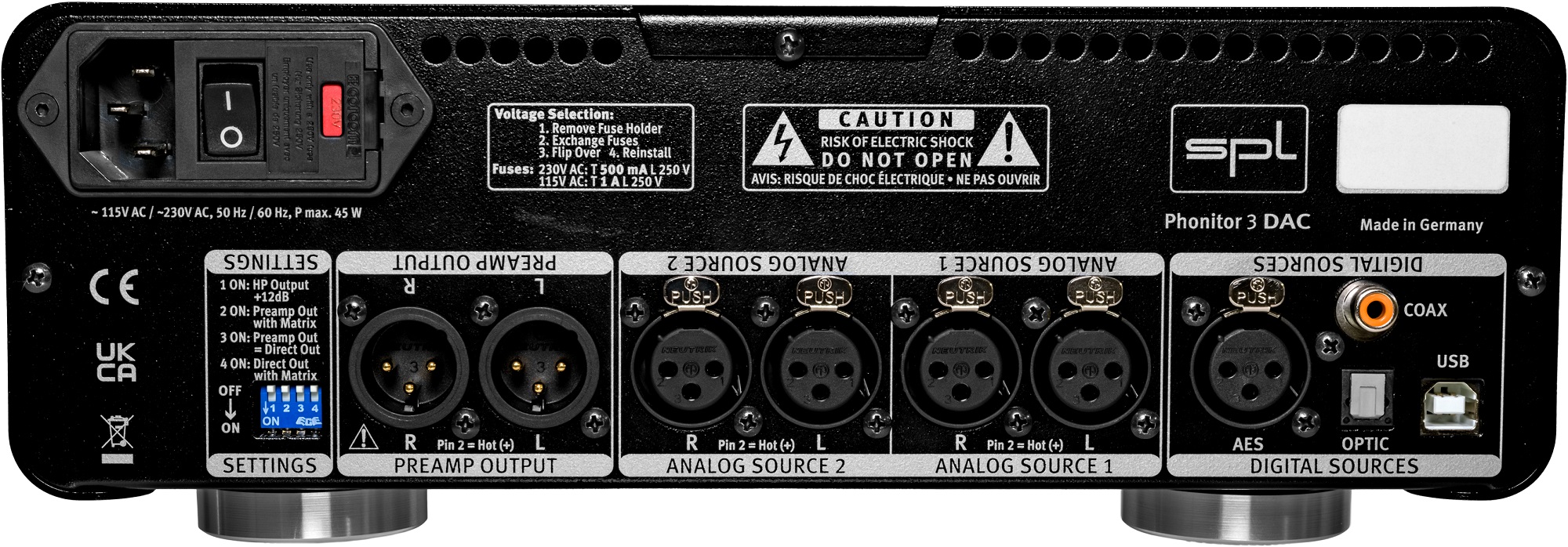Description
Phonitor 3 DAC
The headphone amplifier, monitoring controller and DAC with 120V technology
Phonitor 3 DAC is not only the ultimate headphone amplifier and monitoring controller with 120V technology – the integrated DAC makes it the perfect monitoring centerpiece for demanding producers as well as sound and mastering engineers working with digital sources or in the DAW.
Whether if USB, AES/EBU or S/PDIF – the integrated DAC with analog SLP120 converts digital PCM audio signals with a resolution of 32 bit and a sampling rate of up to 768 kHz. It converts DSD signals with a resolution of up to DSD256.
On the analog side, the Phonitor 3 DAC, based on the SPL 120V technology, offers the same monitoring quality as the big SPL mastering consoles – on loudspeakers and headphones. The analog Phonitor Matrix allows mixing and mastering on headphones in the highest quality – with the same spatial perception of the stereo stage as on loudspeakers.
Great sound – for headphones
The Phonitor 3 DAC offers connection for a standard headphone with a stereo jack plug on the front. Thanks to the enormous output power, all kind of headphones are driven effortlessly. Thus, it plays out the advantages of the SPL 120V technology and rewards the listener with an honest, detailed and at the same time vivid sound experience.
Great sound – also for loudspeakers
On the rear of the device, Phonitor 3 DAC offers a stereo output which makes it a high-quality monitoring controller for any monitoring situation. Active speakers with an integrated power amplifier or passive speakers in combination with a power amplifier can be connected at this output.
Monitoring at the highest level
Phonitor 3 DAC offers the same key technology – SPL 120V technology – and signal quality as the big SPL DMC and MMC mastering consoles.
Headphones or Speakers
The Output switch – simply switch from headphone to speaker playback. In the center position (Mute), no signal reaches the outputs. The VU meters light up red.
Digital & analog stereo inputs – free choice
Up to six stereo sources can be connected to the Phonitor 3 DAC. The source is selected via the Source switch.
Analog inputs
On the analog side, two analog stereo inputs are offered, each with two XLR line inputs. Professional analog players with balanced outputs and line level can be connected here.
Digital inputs
On the digital side, the Phonitor 3 DAC offers four digital stereo inputs.
USB
The USB input (type B) can be used to directly connect the DAW. No driver installation is required for operation with a Mac or an iDevice. Via USB, the Phonitor 3 DAC converts PCM audio signals with a resolution of 32 bits and a sampling rate of up to 768 kHz as well as DSD signals with a resolution of up to DSD256.
S/PDIF, coaxial
The Input S/PDIF coaxial can also receive a two-channel signal (PCM audio) with sampling rates up to 192 kHz and a bit rate of 16 bits to 24 bits. Unbalanced, 2-wire 75-ohm coaxial cables with RCA connectors are used for signal transmission.
S/PDIF, optical
The S/PDIF optical input can also receive a two-channel signal (PCM audio) with sampling rates of up to 192 kHz and a bit rate of 16 bit to 24 bit. The input jack is an F05 jack. This interface is better known under the Toshiba brand name TOSLINK.
Tip: You should attach importance to the quality of the optical fiber. With inexpensive plastic optical fibers, transmissions with quad sampling rates (176.4kHz/192kHz) may have faults. In this case a glass fiber optic cable should be chosen.
AES/EBU
The AES input provides an input jack which corresponds to a standard XLR input (XLR, female). An AES signal can transport two encoded PCM audio channels with a maximum sampling rate of 192 kHz and a bit rate of 16 bits to 24 bits. This standard is defined under IEC 60958 Type I. Balanced, 3-core, 110 Ohm “twisted pair” cables with XLR plugs are used for connection.
The DAC – the best is just good enough
The converter chip in the Phonitor 3 DAC´s digital-to-analog converter is the highly acclaimed AKM AK4490 Velvet Sound™ premium DAC chip, which thanks to its architecture reproduces the finest sound details. It converts PCM audio at 32-bit resolution and a sampling rate of up to 768 kHz, which is 16 times the resolution of a CD. Direct Stream Digital is also supported up to a resolution of DSD4 or DSD256.
SLP120
The analog output of any DAC chip must be filtered by a low pass filter when entering the analog world. In contrast to all other DACs in the world, the low pass filters here are built using SPL 120V technology, which provides a plus in dynamics and headroom and sound. The DAC in the Phonitor 3 DAC is equipped with the SLP120 – an analog “single low pass” filter with 120V technology.
Milled from solid
The massive 45mm volume control knob milled from aluminum is a haptic highlight. Its mass together with the Alps RK27 “Big Blue” potentiometer enhances the “spoon in the honey” feeling even further and provides perfect control of the monitoring level.
Monitoring without any compromises
The Phonitor 3 DAC is a full-fledged monitor controller:
- Source selection
- Phonitor Matrix with Crossfeed, Speaker Angle and Center Level (the latter can be switched off)
- Mono/Stereo
- Laterality control
- Solo L/R
- Phase inversion for L and R
- L/R Swap
- Output switchable to headphones or speakers
- Mute



Reviews
There are no reviews yet.